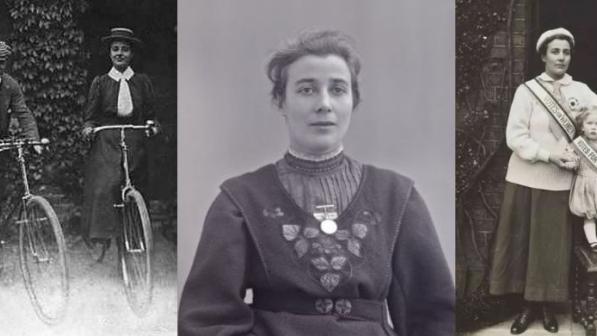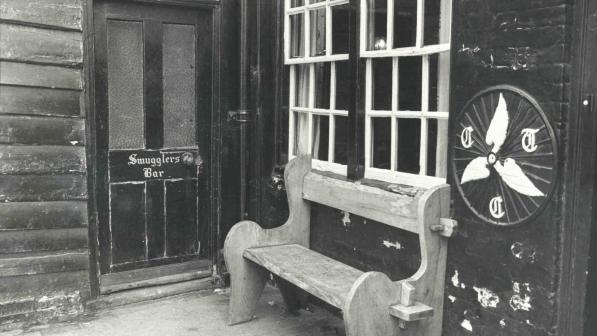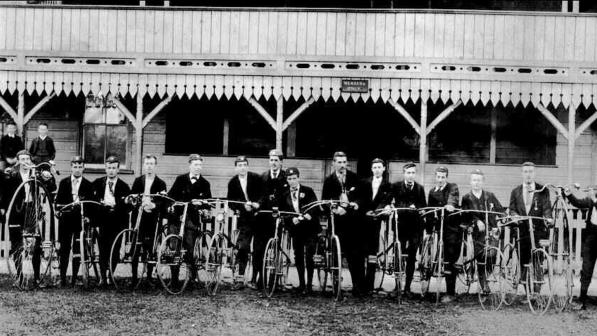Happy Birthday Cycling UK: Celebrating 139 years of cycling history

On 5 August 1878 - exactly 139 years ago today - a forward thinking group of high wheel enthusiasts held the first meeting of The Bicycle Touring Club (BTC). The organisation has evolved over the years, changing its name to the Cyclists’ Touring Club in 1883 and then to Cycling UK in 2016, but many of its founding principles endure today.
Cycling UK’s founding years
When the Bicycle Touring Club was established in the 1870s, the machine of choice was the Ordinary, also known as the highwheeler or penny farthing. As cycling’s popularity boomed, local clubs sprung up across Britain, like the Manchester Wheelers and Amateur Bicycle Club. By the late 1870s, there were approximately 40 bicycle clubs in the UK. Most of them had a racing or social agenda - none addressed the needs of cycle tourists. There was a clear gap in cycling club provision waiting to be filled by the BTC.

Stanley Cotterell, then a medical student studying in Edinburgh, wrote an open letter in 1877 to the Bicycling Times proposing the formation of a club specifically for bicycle tourists. Samuel Hattersley Ineson of the Bradford Bicycle Club responded with interest and helped plan a rally the following year with the objective of establishing such an organisation. An estimated 50-80 cyclists attended the rally, held on 5 August 1878 in Harrogate, Yorkshire. The Bicycle Touring Club was officially launched, the first organisation of its kind. A commemorative plaque now marks the place in Harrogate where the inaugural meeting took place.
Cotterell was elected as Hon Secretary, Ineson was chosen as Hon Treasurer, and other influential cyclists such as cycle-camping expert Thomas Hiram Holding were appointed to an executive committee. Club rules and a constitution were drawn up. Consuls were appointed to act as regional representatives to provide members with advice, maps, hotel recommendations, and tourist information. An optional club uniform was devised consisting of a dark green serge Devonshire jacket, matching knickerbockers, and Stanley helmet.
The main objectives of the BTC were to encourage cycle tourism, safeguard the rights of cyclists, improve road conditions for bicycling, and build a fellowship among cyclists. The BTC Handbook, published in 1878, lists the club’s founding principles as follows:
“To encourage and facilitate touring in all parts of the world, To protect its members against unprovoked assaults, To provide riding or touring companions, To secure and appoint at fixed and reduced rates hotel headquarters in all parts of the country, To enlist the co-operation of leading wheelmen, who should act as consul in every town, and who should render to his fellow members local information of every description, To inculcate and encourage an esprit de corps among the followers of the wheel, similar to freemasonry of every description.”
The first edition of the BTC Monthly Circular, later the CTC Gazette and now called Cycle magazine, appeared in 1878 complete with information on cycle touring, club updates, editorials on cycling topics, and a list of proposed members. The club also began printing maps, negotiating hotel tariffs and rail travel rates, and producing membership badges and cards. By 1879, the BTC was in full swing. The first guide book, A Club Hand Book, appeared in July 1879 which included listings of consuls, hotels, and cycle repair shops, an invaluable resource for cyclists on the open road. The club also started to lobby for road improvements and cyclists’ rights.
Membership grew from 144 in 1878 to 836 by the end of 1879, and showed no sign of stopping. By 1883, it was apparent that tricyclists as well as bicyclists benefited from club services. The BTC’s name was changed to the Cyclists’ Touring Club (CTC) to better represent its membership body, now numbering 10,627. By 1888, the club boasted 20,000 members and at its Victorian peak in 1899 had 60,449 members. It was without a doubt the largest and most influential cycling organisation of its time.
Cycling advocacy and history in action
Before long, the CTC became known for taking action on behalf of cyclists. The club’s commitment to road safety, for example, dates back to its origins when the club first petitioned for better road surfaces and danger signs on steep hills. Access to space to cycle was recognised as an important issue, and the CTC successfully lobbied to have the bicycle ban lifted from Richmond Park and Regents Park in 1885. In 1886, the well-known winged wheel insignia was introduced. Soon, cast-iron signs began to appear on the walls of inns and repair shops endorsed by the club. Wheelmen and women could be confident that they would receive a warm welcome at establishments bearing the CTC sign in an age when hostility towards cycling persisted.
The club energetically campaigned for better treatment of cyclists on the road, the repeal of anti-cycling bylaws, and the legal recognition of bicycles as carriages. The CTC provided legal defence for cyclists charged unjustly for highway infractions or injured in accidents. One of the best known cases backed by the CTC was Lady Harberton’s action against the landlady of the Hautboy Hotel, Ockham who had refused her service for wearing a rational cycling costume. Lady Harberton and the CTC lost the case, but the hotel was stripped of its CTC recommendation. In 1936, the CTC in introduced one of the first cycling proficiency programmes in the hope of preventing accidents and improving cyclists’ experiences on the road.

Another area where Cycling UK has been a historic leader is in recognising that cycling is open to everyone. When the BTC was founded, the nature of highwheeling meant that membership was limited to men of means who could control and afford the dangerous and expensive machines.
That is not to say, however, that women were excluded from cycling or club life. In an 1897 interview with Wheelwoman magazine, longstanding CTC executive member ER Shipton recalled that fourteen lady tricyclists attended an early club run. In 1880, the CTC made the precedent setting decision to admit women as full members, making it the first cycling club to remove the gender bar to membership. The first woman to register was Mrs W.D. Welford, wife of the club secretary and rider of a salvo sociable tricycle. The introduction of the Safety bicycle and the cycling craze that went with it saw membership among women increase. Membership lists published in the CTC Gazette show that by the mid-1890s approximately one third of new joiners were female. The class structure of the CTC also changed, from wealthy and upper middle class in its early years to more diverse by 1900 as cycling became an increasingly affordable pastime.
Many of these early campaigns have modern parallels in Cycling UK such as Fill That Hole, The Cyclists’ Defence Fund, Bikeability and Belles on Bikes. The early spirit of the BTC and CTC lives on in Cycling UK’s commitment to cycling rights and advocacy.
139 years on
At the turn of the century, cycling’s popularity decreased and it went from a fashionable leisure fad to practical mode of transportation and recreation. CTC membership plummeted to about 8,500 in 1918. In 1906, the club considered amending its constitution to include automobile drivers and changing its name to the Touring Club, a motion which failed in the High Court. Nonetheless, the CTC survived cycling’s ups and down in the 20th and 21st centuries. Membership numbers recovered to around 50,000 by 1950 and to 67,000 today.
Cycling is currently enjoying a renaissance. As more and more people take up cycling, Cycling UK will have an even greater part to play. Like its predecessors the BTC and CTC, Cycling UK offers support and a voice to all cyclists, from those getting on a bike for the first time to veteran riders on tour. As we celebrate 138 years, it is important to remember the historical contribution this organisation has made and appreciate how the campaigns fought over those many years benefit all cyclists today.
Dr. Sheila Hanlon is Cycling UK's historian, she will be exploring our rich cycling past and present in an ongoing series on the history section of Cycling UK's website.
Further reading
Green, George. This Great Club of Ours: The Story of the CTC. CTC, London, 1953.
Lightwood, James T. The Cyclists’ Touring Club: Being the Romance of Fifty Years’ Cycling. CTC, London, 1928.
Oakley, William. Winged Wheel: The History of the first hundred years of the Cyclists’ Touring Club. CTC, Godalming, 1977.
The Golden Book of Cycling, “Stan Cotterell,” http://thepedalclub.org/archives/stan-cotterell
Winged Wheels, http://www.wingedwheels.info
You can find history highlights on the Cycling UK History Timeline.




